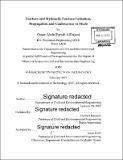| dc.contributor.advisor | Herbert Einstein. | en_US |
| dc.contributor.author | AlDajani, Omar AbdulFattah | en_US |
| dc.contributor.other | Massachusetts Institute of Technology. Department of Civil and Environmental Engineering. | en_US |
| dc.date.accessioned | 2017-06-06T19:23:18Z | |
| dc.date.available | 2017-06-06T19:23:18Z | |
| dc.date.copyright | 2017 | en_US |
| dc.date.issued | 2017 | en_US |
| dc.identifier.uri | http://hdl.handle.net/1721.1/109646 | |
| dc.description | Thesis: S.M., Massachusetts Institute of Technology, Department of Civil and Environmental Engineering, 2017. | en_US |
| dc.description | Cataloged from PDF version of thesis. | en_US |
| dc.description | Includes bibliographical references (pages 152-154). | en_US |
| dc.description.abstract | Even though hydraulic fracturing has been in use for more than six decades to extract oil and natural gas, the fundamental mechanism to initiate and propagate these fractures remains unclear. Moreover, it is unknown how the propagating fracture interacts with other fractures in the Earth. The objective of this research is to gain a fundamental understanding of the hydraulic fracturing process in shales through controlled laboratory experiments where the underlying mechanisms behind the fracture initiation, -propagation, and -coalescence are visually captured and analyzed. Once these fundamental processes are properly understood, methods that allow one to produce desired fracture geometries can be developed. Two different shales were investigated: the organic-rich Vaca Muerta shale from the Neuquén Basin, Argentina and the clay-rich Opalinus shale from Mont Terri, Switzerland, which were shown to vary in mineralogy and mechanical properties. Specimen preparation techniques were developed to successfully dry cut a variety of shales and produce prismatic specimens with pre-existing artificial fractures (flaws). The Vaca Muerta shale specimens were subjected to a uniaxial load which induces fractures emanating from the flaws. Two geometries were tested: a coplanar flaw geometry (2a-30-0) resulting in indirect coalescence and a stepped flaw geometry (2a-30-30) resulting in direct coalescence. These "dry" fracture experiments were analyzed in detail and corresponded well to the behavior observed in the Opalinus shale. This result shows that the fracture behavior in Opalinus shale can be extended to other shales. A test setup capable of pressurizing an individual flaw in prismatic shale specimens subjected to a constant uniaxial load and producing hydraulic fractures was developed. This setup also allows one to monitor internal flaw pressure throughout the pressurization process, as well as visually capture the processes that occur when the shale is hydraulically fractured. Three fracture geometries in Opalinus shale were tested using this developed setup: single vertical flaw (SF-90) for the proof of concept of the test setup, stepped flaw geometry (2a-30-30) which resulted in no coalescence, and stepped flaw geometry (2a-30-60) which resulted in indirect coalescence. Of particular interest were the observed lag between the crack tip and the liquid front as well as the way the hydraulic fracture propagates across and along bedding planes. A systematic difference was observed when comparing crack interaction behavior for "dry" and hydraulic fracture experiments for various flaw geometries. The result of this thesis will add to fundamental knowledge of how fractures behave and interact under various loading conditions, flaw geometries, and materials serving as a basis for predictive fracture models. | en_US |
| dc.description.statementofresponsibility | by Omar AbdulFattah AlDajani. | en_US |
| dc.format.extent | 319 pages | en_US |
| dc.language.iso | eng | en_US |
| dc.publisher | Massachusetts Institute of Technology | en_US |
| dc.rights | MIT theses are protected by copyright. They may be viewed, downloaded, or printed from this source but further reproduction or distribution in any format is prohibited without written permission. | en_US |
| dc.rights.uri | http://dspace.mit.edu/handle/1721.1/7582 | en_US |
| dc.subject | Civil and Environmental Engineering. | en_US |
| dc.title | Fracture and hydraulic fracture initiation, propagation and coalescence in shale | en_US |
| dc.type | Thesis | en_US |
| dc.description.degree | S.M. | en_US |
| dc.contributor.department | Massachusetts Institute of Technology. Department of Civil and Environmental Engineering | |
| dc.identifier.oclc | 986791506 | en_US |
